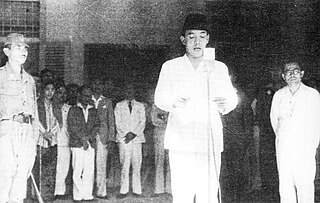
The Indonesian National Revolution, also known as the Indonesian War of Independence, was an armed conflict and diplomatic struggle between the Republic of Indonesia and the Dutch Empire and an internal social revolution during postwar and postcolonial Indonesia. It took place between Indonesia's declaration of independence in 1945 and the Netherlands' transfer of sovereignty over the Dutch East Indies to the Republic of the United States of Indonesia at the end of 1949.

The Royal Netherlands East Indies Army was the military force maintained by the Kingdom of the Netherlands in its colony of the Dutch East Indies, in areas that are now part of Indonesia. The KNIL's air arm was the Royal Netherlands East Indies Army Air Force. Elements of the Royal Netherlands Navy and Government Navy were also stationed in the Netherlands East Indies.
The Ratu Adil, literally meaning Just Ruler, is a messianic figure found in Indonesian folklore, more precisely in Javanese tradition. It is believed that they will establish universal peace and justice in the manner of similar figures, such as King Arthur in European folklore. The Ratu Adil is first mentioned in the Pralembang Joyoboyo, the set of prophecies ascribed to the 12th century King Jayabaya of Kediri. The Ratu Adil is described in Jayabaya's prophecies, also according to the 19th century poet Ranggawarsita; as a figure who has an exceptional ability to lead the country.

The Prime Minister of the Republic of Indonesia was a political office in Indonesia which existed from 1945 until 1966. During this period, the prime minister was in charge of the Cabinet of Indonesia, one of the three branches of government along with the People's Representative Council and the president. Following his 1959 decree, President Sukarno assumed the role and powers of prime minister until his resignation in 1966.
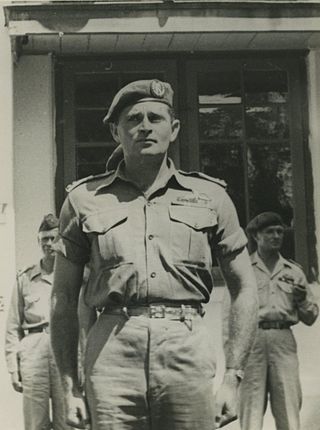
Raymond Pierre Paul Westerling was a Dutch military officer of the Royal Netherlands East Indies Army. He orchestrated a counter-guerrilla operation in Sulawesi during the Indonesian National Revolution after World War II and participated in a coup attempt against the Government of Indonesia in January 1950, a month after the official transfer of sovereignty. Both actions were denounced as war crimes by the Indonesian authorities. Born in the Ottoman Empire, despite his nickname, The Turk, Westerling was of mixed Dutch and Greek descent.

Operation Kraai was a Dutch military offensive against the de facto Republic of Indonesia in December 1948, following the failure of negotiations. With the advantage of surprise, the Dutch managed to capture the Indonesian Republic's temporary capital, Yogyakarta, and seized Indonesian leaders such as de facto Republican President Sukarno. This apparent military success was, however, followed by guerrilla warfare, while the violation of the Renville Agreement ceasefire diplomatically isolated the Dutch. This led to the Dutch–Indonesian Round Table Conference and recognition of the United States of Indonesia.

Military Regional Command III/Siliwangi is an Indonesian Army Regional Military Command that covers Banten and West Java province.

Korps Speciale Troepen was a Royal Netherlands East Indies Army (KNIL) special forces unit that was established for deployment against the Indonesian revolutionaries during the Indonesian National Revolution. It was formed in 1948 with the Depot Speciale Troepen at its core and disbanded alongside the Royal Netherlands East Indies Army in 1950, by which time it had been renamed to the Regiment Speciale Troepen. The DST consisted of about 570 men at its establishment in 1945 and had a precursor in the Korps Insulinde that conducted clandestine operations during the Japanese occupation of the Dutch East Indies. In June 1949, 250 men of the 1st Parachute Company were integrated into the Corps. The KST, which would reach a maximum strength of 1250 men, was composed of Dutch war volunteers (OVWs), Eurasians and native soldiers, including Moluccans. The present day Korps Commandotroepen of the Royal Netherlands Army is considered a continuation of the RST.

Lieutenant General Siswondo Parman or more popularly known such as in streets name as S. Parman, was a soldier in the Indonesian Army, and was kidnapped from his home in Jakarta by members of the 30 September Movement in the early hours of October 1. He was later killed at Lubang Buaya.

The Central Indonesian National Committee, also known as the Central National Committee, was a body appointed to assist the president of the newly independent Indonesia. Originally purely advisory, it later gained assumed legislative functions. The Working Committee of the KNIP became part of the People's Representative Council when Indonesia became a unitary state in 1950.

The Republic of the United States of Indonesia Cabinet was established as a result of the formation of the United States of Indonesia following the transfer of sovereignty from the Dutch colonial power. It lasted less than a year before Indonesia became a unitary state.

Sultan Hamid II was the 7th Sultan of Pontianak and the only President of the State of West Kalimantan from 1946 to its disestablishment in 1950. He was the eldest son of Sultan Syarif Muhammad Alkadrie. He was of mixed Malay-Arab ancestry and was raised by two British nationals — Salome Catherine Fox and Edith Maud Curteis.

The Federal Consultative Assembly, (BFO) was a committee established on 8 July 1948 to discuss the form of the planned federal United States of Indonesia. Its membership comprised the leaders of the various federal states established by the Dutch in the areas they occupied following their attack on the areas of Indonesia controlled by republican forces during the Indonesian National Revolution (1945–1949). It took part in negotiations with the Dutch in August and September 1948, and participated in the Dutch–Indonesian Round Table Conference at which the Dutch agreed to hand over sovereignty to the United States of Indonesia.

The APRA coup d'état was a coup d'état by Raymond Westerling's Legion of the Just Ruler (APRA) to capture Bandung and Jakarta, with the aim to overthrow Sukarno's unitary Republic of Indonesia. Westerling was a demobilised Dutch Captain of the KNIL, who sought to preserve the federal Republic of the United States of Indonesia, which retained the support of the Netherlands and various minority elements. Westerling's forces succeeded in capturing Bandung in the early hours of 23 January 1950.
The South Sulawesi Campaign was a campaign during the Indonesian National Revolution. It was a counter-insurgency offensive of the special forces of the KNIL against Indonesian infiltrations from Java and pro-Indonesian local militias. It was masterminded by the controversial Raymond Westerling, a captain in the KNIL. Westerling's operation, which started in December 1946 and ended in February 1947, succeeded in eliminating the insurgency and undermining local support for the Republicans by instituting summary executions of suspected enemy fighters.
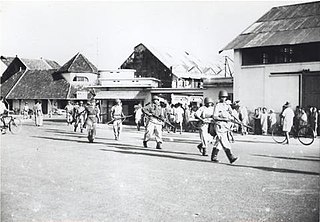
The Makassar Uprising, also known as Andi Aziz rebellion, was a skirmish in Makassar, Sulawesi, between former Royal Dutch East Indies Army soldiers under Captain Andi Aziz and the Republic of the United States of Indonesia government. The purpose of the uprising was to revolt against the incorporation of the Indonesian federated "states" into the Indonesian Republic. However, the uprising was quashed in a little over two weeks when troops under Lieutenant Colonel Suharto and Colonel Alexander Evert Kawilarang arrived at Makassar to find only light resistance.

The State of Pasundan was a federal state (negara bagian) formed in the western part of the Indonesian island of Java by the Netherlands in 1948 following the Linggadjati Agreement. It was similar to the geographical area now encompassed by the current provinces of West Java, Banten and Jakarta.

The Darul Islam rebellion was a war waged between 1949 and 1962 by the Islamic State of Indonesia, commonly known as Darul Islam, to establish an Islamic state in Indonesia. The rebellion began when Sekarmadji Maridjan Kartosuwirjo, a former Indonesian nationalist who refused to recognize the new Republic of Indonesia. Instead, he proclaimed the establishment of the Islamic State of Indonesia on 7 August 1949.
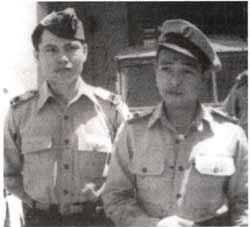
Adolf Gustaaf Lembong was an Indonesian military officer involved in guerrilla warfare against the Japan in the Philippines during World War II and subsequently in the struggle for Indonesian independence. He was killed during the APRA coup d'état in Bandung.
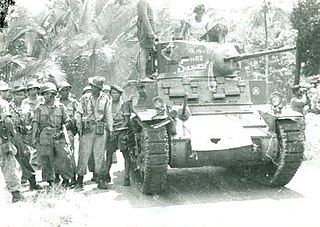
The Invasion of Ambon was a combined Indonesian military operation which aimed to seize and annex the self proclaimed Republic of South Maluku.



















